Re-staking returns to the spotlight, how is the liquidity of LRTs?
Author: Kairos Research
Compiled by: Shenchao TechFlow
Key Takeaways:
LRT may integrate with centralized exchanges and introduce market makers to the risks/rewards of being liquidity providers in these centralized venues.
The liquidity of liquidity re-staked tokens (LRT) is not remarkably good; overall liquidity is acceptable, but the nuances associated with each individual LRT vary significantly, and these differences will only grow with the divergence of long-term delegation strategies.
All these LRT providers, except for EtherFi, have not enabled withdrawal features.
Liquidity re-staking is expected to be a winner-takes-all market structure, where liquidity brings more liquidity.
Main Text:
EigenLayer's first AVS officially launched on the mainnet.
Today, EigenLabs' data availability AVS—EigenDA—was released on the mainnet, marking the official start of the re-staking era. While the EigenLayer market still has a long way to go, one trend has become very clear: liquidity re-staked tokens (LRT) will become the primary avenue for re-stakers. Over 73% of all EigenLayer deposits are made through LRTs, but how liquid are these assets? This report will delve into this question and explain the nuances surrounding EigenLayer.

Introduction to EigenLayer and Liquidity Re-staked Tokens
EigenLayer achieves the reuse of ETH on the consensus layer through a new crypto-economic tool called "re-staking." ETH can be re-staked on EigenLayer in two main ways: through native ETH re-staking or by using liquid staking tokens (LST). The re-staked ETH is then used to secure other applications, known as Active Validation Services (AVS), allowing re-stakers to earn additional staking rewards.
The main complaint users have about staking and re-staking is the opportunity cost of staking ETH. This issue is resolved for native ETH staking using liquid staking tokens (LST), which can be viewed as liquid receipt tokens representing the amount of ETH staked by users. The LST market on Ethereum currently stands at approximately $48.65 billion, making it the largest in the DeFi space. Today, LSTs account for about 44% of all ETH staked, and as re-staking becomes more popular, we expect the liquidity re-staked token (LRT) sector to follow a similar, if not more aggressive, growth pattern.
While LRTs share some characteristics with LSTs, they have a distinctly different mission. The ultimate goal of each LST is essentially the same: to stake users' ETH and provide them with liquid receipt tokens. However, for LRTs, the ultimate goal is to delegate the user's staking representation to one or more operators, who then support a basket of AVS. Each individual operator can choose how to allocate their delegated stake among these various AVS. Therefore, the operators to whom LRT delegates its stake have a significant impact on overall activity, operational performance, and the security of the re-staked ETH. Finally, they must also ensure proper risk assessment for the unique AVS supported by each operator, as the risk cuts may vary depending on the services provided. Note that risk cuts will essentially be zero for most AVS in the early stages of listing, but over time, we will gradually see the "training wheels" removed, making the staking market increasingly permissionless.
Editor’s Note: "Training wheels" refers to protective measures provided in the initial stages to avoid or reduce risks, which will gradually be removed as time goes on and participants' capabilities improve, making the system or market more open and free.
However, despite the differences in structural risks, one similarity remains: LRTs lower the opportunity cost of re-staking capital by providing liquid receipt tokens that can be used as productive collateral in DeFi or exchanged to reduce withdrawal periods. This last point is particularly important, as one of the main advantages of LRTs is that they circumvent the traditional withdrawal period, which is seven days for EigenLayer. Given this core principle of LRTs, we expect to see net selling pressure on them as the entry barrier for re-staking is so low, but the exit barrier is so high, making the liquidity of these LRTs their lifeline.
Therefore, as the total staked value of EigenLayer continues to rise, it is important to understand the driving factors behind the protocol's growth and how these will affect inflows/outflows in the coming months. At the time of writing, 73% of EigenLayer deposits are made through liquidity re-staked tokens. To put this in context, on December 1, 2023, LRT deposits were approximately $71.74 million. Today, on April 9, 2024, they have grown to about $10 billion, achieving an astonishing growth of over 13,800% in less than four months. However, as LRTs continue to dominate the growth of EigenLayer's re-staking deposits, there are some important factors to consider.
Not all LRTs are composed of the same underlying assets.
LRTs will have different staking delegations to AVS over the long term, but the short-term differences are minimal.
Most importantly, the liquidity characteristics among various LRTs vary greatly.
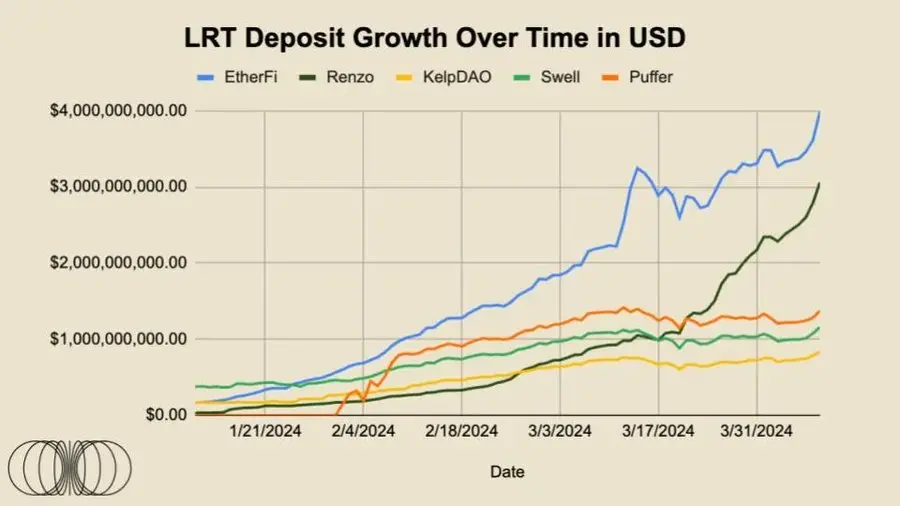
Given that liquidity is the most critical advantage of LRTs, most of this report will focus on the last point.
The speculative nature of Eigen Points has greatly stimulated the current bull market for EigenLayer deposits, and we can assume this will translate into some form of airdrop allocation for a potential EIGEN token. Currently, there are no AVS rewards ongoing, which means that besides natural staking rewards, there are no incremental yields on these LRTs. To drive and maintain a total staked value exceeding $133.5 billion, the AVS market must naturally find a balance between the incremental yields needed by re-stakers and the natural price that AVS are willing to pay for security.
For LRT depositors, we have already seen EtherFi's tremendous success with the launch of the ETHFI governance token airdrop, currently valued at around $6 billion. Considering all the factors mentioned above, it can be expected that after the launch of EIGEN and other anticipated LRT airdrops, some capital flows may gradually increase.
However, in terms of reasonable yields, users may find it challenging to locate higher yields in the Ethereum ecosystem that do not involve EigenLayer. There are several interesting yield opportunities within the Ethereum ecosystem. For example, Ethena is a synthetic stablecoin backed by staked ETH, which also has a hedged short position in ETH futures. The protocol currently offers an annual yield of about 30% on its sUSDe product. Additionally, as users become increasingly familiar with interoperability and cross-chain bridging, yield seekers may look elsewhere, potentially driving capital outflows from Ethereum's productive capital.
Despite some complexities, overall, we believe it is reasonable to assume that, aside from the potential EIGEN token airdrop that may occur for re-stakers, there will not be any larger incremental staking yield events, and large, blue-chip AVS that have already raised billions of dollars at high valuations in private markets may also issue their tokens to re-stakers. Therefore, it can be assumed that after these events, a certain proportion of ETH will flow out of the EigenLayer deposit contracts through withdrawals.
Given that EigenLayer withdrawals have a seven-day cooldown period, and the vast majority of funds are re-staked through LRTs, the fastest exit route will be to convert your LRT back to ETH. However, the liquidity characteristics among various LRTs vary greatly, and many LRTs may not be able to exit at market prices on a large scale. Furthermore, at the time of writing, EtherFi is the only LRT project that has enabled withdrawal features.
We believe that LRTs trading below the price of their underlying assets may subject re-staking protocols to painful arbitrage cycles. Imagine if an LRT trades at 90% of its underlying ETH value; market makers/arbitrageurs might buy that LRT and continue the redemption process, assuming the price of ETH is hedged, expecting to gain about 11.1% in net profit. The general rule of supply and demand is that LRTs are more likely to face net selling pressure, as sellers may avoid the seven-day withdrawal queue. Conversely, users seeking to re-stake may immediately deposit their ETH, making it of little benefit for them to purchase LRTs on the open market.
By the way, we expect that once multiple AVS go live with protocol rewards and full implementation of risk cuts, the further choice of whether to exit or continue re-staking will ultimately depend on the incremental yields provided through re-staking. Personally, I believe many underestimate the incremental yields offered through re-staking. However, that is a discussion for another time.
Data Tracking
The data section of this month's report begins below and will track the growth, adoption, and liquidity status of the top five LRTs, as well as any noteworthy news that we believe should be highlighted.

LRT Liquidity and Trading Volume
Although staking through LSTs and LRTs has more key advantages than traditional staking, this utility can be nearly entirely undermined if the LRTs themselves do not possess sufficient liquidity. Liquidity refers to "the efficiency or ease with which an asset can be converted into cash without affecting its market price." The issuers of LRTs must ensure that there is sufficient liquidity on-chain so that large holders can exchange receipt tokens in a liquidity pool where the prepared asset value is nearly 1:1.
Each existing LRT has very unique liquidity characteristics. For various reasons, we expect these situations to persist:
Certain protocols will receive liquidity for their LRTs from investors and users in the early stages.
Incentives for liquidity through subsidies, token issuance, on-chain bribery systems, or through "points" anticipated from these events.
Some protocols will have more complex and concentrated liquidity providers who will maintain their LRTs close to peg levels with relatively low total dollar liquidity.
It is important to note that concentrated liquidity can only function within a smaller price range, and any price movements beyond the selected range will have a significant impact on the price.
Below is a very simple analysis of the on-chain pool liquidity of the top five largest LRTs on the Ethereum mainnet (+ Arbitrum). Exit liquidity refers to the cash-like dollar value in the LRT liquidity pool.
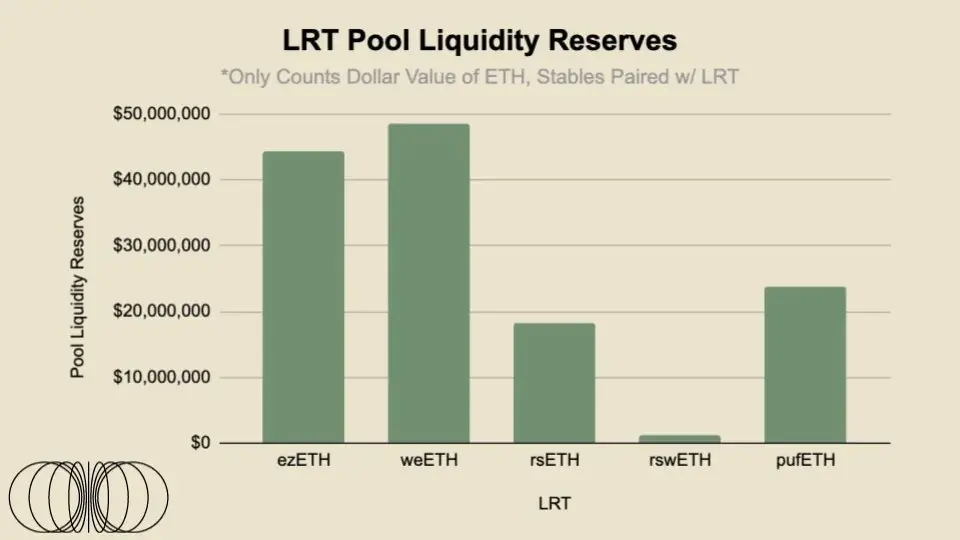

For the liquidity of the pools of these five largest LRTs, there is a total of over $136 million in liquidity available, spanning Curve, Balancer, and Uniswap. However, to gain a clearer understanding of how liquid each LRT is, we will apply a liquidity/market cap ratio for each asset.
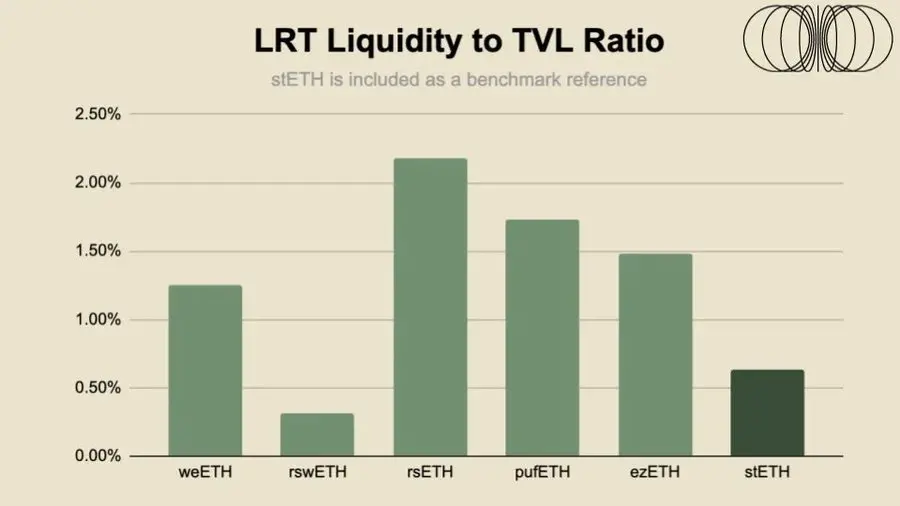
Compared to top LST—stETH, the liquidity ratios of LRTs are not overly concerning. However, considering the increased risks of re-staking and the additional seven-day withdrawal period added by EigenLayer in Ethereum's unlock queue, the liquidity of LRTs may be more critical than that of LSTs. Additionally, stETH trades on several large centralized exchanges, with order books managed by professional HFT firms, meaning that the liquidity of stETH is far beyond what is seen on-chain. For example, on OKX and Bybit, there is approximately over $2 million in +-2% order book liquidity. Therefore, we believe LRTs may also explore this avenue, integrating with centralized exchanges and introducing market makers to the risks/rewards of being liquidity providers in these centralized venues. In next month's article, we will delve deeper into stable pool liquidity, x*y=k liquidity, and the distribution of concentrated liquidity among top LRT trading pairs.
LRT Pegging Data
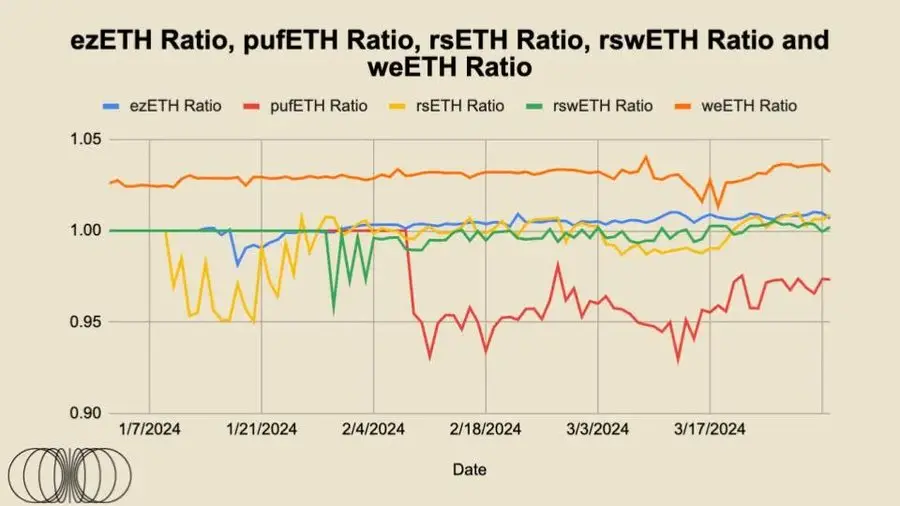
From the above chart, it can be seen that the trading prices of rsETH, rswETH, and ezETH are relatively close to a 1:1 peg with ETH, with slight premiums, given that these tokens are non-interest-bearing tokens, unlike stETH, which automatically compounds interest rewards and reflects in the token price. This is why the current price of 1 wstETH is about 1.16 ETH. Theoretically, over time, "fair value" should continue to increase, as it is determined by time * staking rewards, which will then reflect in the increasing fair value of these tokens.
The pegging of these LRTs is very important, as it essentially represents the level of trust market participants have in the overall project, directly determined by the capital invested or the willingness of arbitrageurs to trade these premiums and discounts to maintain the trading "fair value" of the tokens. Note that all these tokens are non-benchmark tokens, meaning they automatically compound, but trade based on the redemption curve.

It can be seen that for the two most liquid LRTs, ezETH and weETH, their trading has remained relatively stable over time, mostly aligning with fair value. The slight deviation of EtherFi's ezETH from fair value is primarily due to the launch of its governance token, with opportunistic users cashing out from this token, naturally leading other market participants to join in trading to exchange for discount arbitrage. We may see similar events occur after Renzo launches its governance token.

KelpDAO's rsETH traded at a discount to fair value at launch but has gradually stabilized back to levels aligned with fair value.

As for rswETH, it has traded below its fair value for most of the time, but recently seems to have reached parity with its fair value. Among all these LRTs, pufETH is the main outlier, as it trades only at a discount. However, this trend seems to be coming to an end, as it is moving towards parity with the fair value based on its underlying asset value.
It should be noted again that all these LRT providers, except for EtherFi, have not enabled withdrawal features. We believe that sufficient liquidity combined with the ability for users to withdraw at any time will provide a strong incentive for market participants, meaning that a significant portion of liquidity needs to be sourced from the entire DeFi ecosystem.
LRT in the Broader DeFi Ecosystem
Once LRTs further integrate into the broader DeFi ecosystem, especially in lending markets, their pegging importance will significantly increase. For example, in the current money market, LSTs (particularly wstETH/stETH) are the largest collateral assets on Aave and Spark, with supplies of approximately $4.8 billion and $2.1 billion, respectively. As LRTs become more integrated into the broader DeFi ecosystem, we expect these numbers to eventually surpass the supply of LSTs, especially as the broader market gains a deeper understanding of risks and product structures, and as they become more long-term credible over time. Additionally, both Compound and Aave have governance measures to include Renzo's ezETH.
However, as previously mentioned, liquidity will remain the lifeline for these products to ensure the breadth and depth of their DeFi integration, as well as their long-term viability. We have seen that LST decoupling events can trigger a series of chaos; click here to read more.
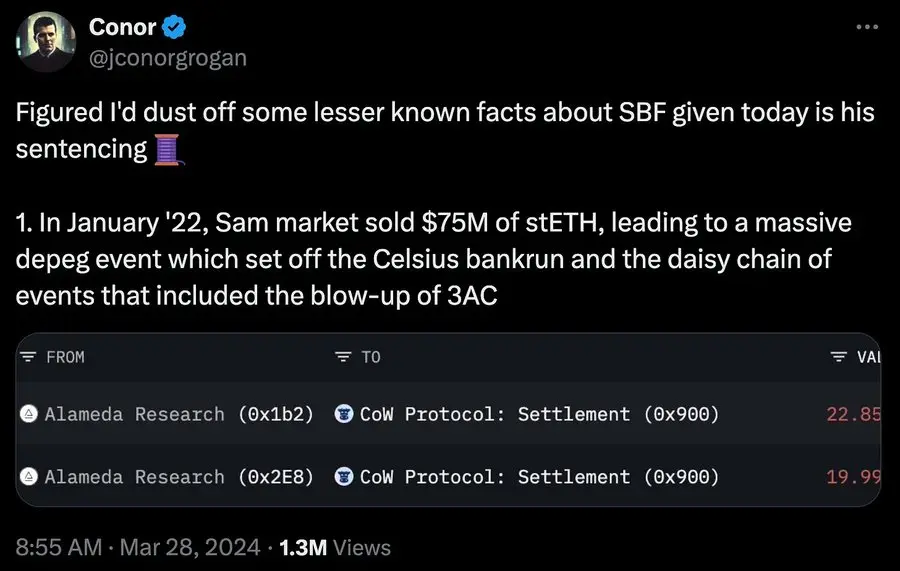
Concluding Thoughts
Although stETH gained early advantages and dominates due to its first-mover status, the series of LRTs mentioned in this report were largely launched around the same time, and the market momentum is strong. We expect this to be a winner-takes-all market structure, as the power law applies to most liquid assets; simply put, liquidity brings liquidity. This is why Binance continues to dominate CEX market share despite various controversies and turmoil.
In summary, the liquidity of liquidity re-staked tokens is not remarkably good. Overall liquidity is acceptable, but the nuances associated with each individual LRT vary significantly, and these differences will only grow with the divergence of long-term delegation strategies. From a mental model perspective, it may be easier for first-time users to view LRTs as collateral ETFs. Many will compete for the same market share, but in the long run, configuration strategies and fee structures may determine the winners and losers. Furthermore, as products become increasingly differentiated, liquidity will become more important due to the varying lengths of withdrawal periods. In the cryptocurrency space, seven days can sometimes feel like a month of normal time, as global markets operate 24/7. Finally, as these LRTs begin to integrate into lending markets, pool liquidity will become increasingly important, as liquidators will only be willing to take on acceptable risks due to the varying liquidity conditions of the collateral involved. We believe that token incentive mechanisms may play a crucial role in this regard, and we look forward to delving into different token models after other LRT providers may conduct airdrop activities.










